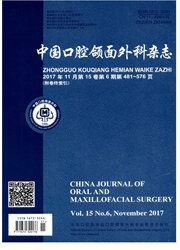

 中文摘要:
中文摘要:
目的 :探讨早期吞咽训练对舌癌术后患者吞咽障碍的治疗效果及对生活质量的影响。方法 :选择舌癌术后患者134例,年龄36-74岁,随机分层分为治疗组和对照组(各67例),治疗组术后第10天开始进行10 d的吞咽训练,对照组不给予吞咽干预。采用吞咽筛查量表(10-Item Eating Assessment Tool,EAT-10)和肿瘤治疗功能评估—头颈问卷(中文版)(Functional Assessment of Cancer Therapy-Head and Neck,FACT-H&N)评价吞咽障碍程度和生活质量,记录吞咽训练前、后(术后10 d和20 d时)吞咽功能和生活质量的变化。采用SPSS13.0软件包进行组间比较及自身前后比较。EAT-10标准分与FACT-H&N总分之间作Pearson相关和线性回归分析。结果:治疗组吞咽训练后EAT-10标准分和FACT-H&N总分分别低于和高于治疗前(P〈0.05);对照组术后10 d与术后20 d两组量表之间差异无统计学意义(P〉0.05);治疗组吞咽训练后EAT-10标准分和FACT-H&N总分分别低于和高于对照组术后20 d(P〈0.05)。EAT-10标准分和FACT-H&N总分之间存在负相关(P〈0.01)。结论 :早期吞咽训练有助于提高舌癌术后患者的吞咽功能和生活质量。
 英文摘要:
英文摘要:
PURPOSE: The aim of the present study was to evaluate the effect of early swallowing treatment on dysphagia and quality of life (QOL) in tongue cancer patients after surgery. METHODS: A sample of 134 tongue cancer patients aging 36 to 74 years was divided into treatment group (67 patients) and control group (67 patients). All patients were scheduled to undergo partial tongue resection and flap reconstruction. Changes in dysphagia and QOL before and after swallowing training (10 days and 20 days after operation) were measured. The 10-item Eating Assessment Tool (EAT-IO) and the Functional Assessment of Cancer Therapy-Head and Neck (FACT-H&N) were used to evaluate the severity of dysphagia and QOL, respectively. The data were analyzed by using SPSS 13.0 software package. RESULTS: The EAT-10 scores were significantly higher and the FACT-H&N scores were significantly lower than those measured in the treatment group after swallowing treatment. No significant difference was observed in either score between the two time points in the control group. The EAT-10 scores and FACT-H&N scores of the treatment group after swallowing training were siguificantly lower and higher, respectively, than those measured 20 days after operation in the control group (P〈0.05). Lower EAT-10 scores were associated with higher FACT-H&N scores (P〈0.01). CONCLUSIONS: Early identification and management of postoperative dysphagia in tongue cancer patients can improve swallowing outcomes and QOL.
 同期刊论文项目
同期刊论文项目
 同项目期刊论文
同项目期刊论文
 miR-639 regulates transforming growth factor beta-induced epithelial-mesenchymal transition in human
miR-639 regulates transforming growth factor beta-induced epithelial-mesenchymal transition in human Reconstruction of through-and-through oral cavity defects with folded extended vertical lower trapez
Reconstruction of through-and-through oral cavity defects with folded extended vertical lower trapez 期刊信息
期刊信息
